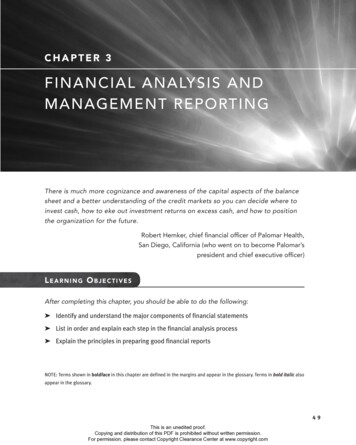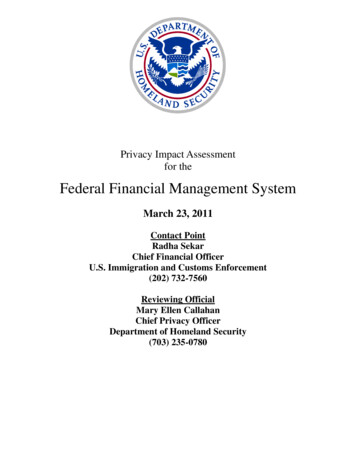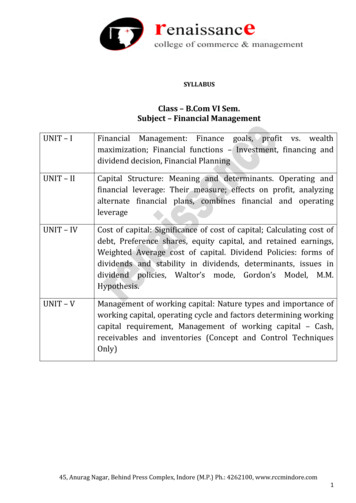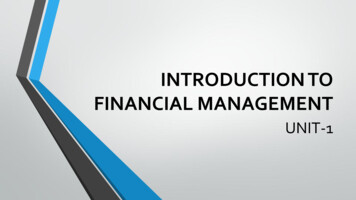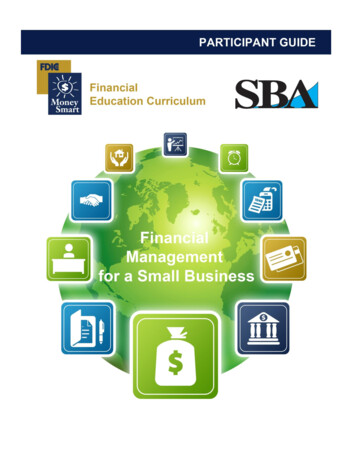
Transcription
Financial Management for a Small BusinessParticipant GuideTable of ContentsWelcome . 3What Do You Know? Financial Management for a Small Business . 4Pre-Test . 5Benefits of Financial Management . 7Budgeting . 7Discussion Point #1: Budgeting. 7Bookkeeping . 8Cash Flow . 9Discussion Point #2: Cash Flow Projection . 10Profit and Loss (P&L) Statement . 12Discussion Point # 3: P&L Statement . 12Business Financing . 14Loans . 15Five Key Points to Remember. 18For Further Information . 19Post-Test. 20Evaluation Form . 22DISCLAIMERThese training materials are intended as general guidance only and may or may not apply to a particular situationbased on the circumstances. The materials do not create any legal rights or impose any legally binding requirementsor obligations on the Federal Deposit Insurance Corporation (FDIC) and U.S. Small Business Administration (SBA).The FDIC and SBA make no claims or guarantees regarding the accuracy or timeliness of this information andmaterial.The content of this training material is not designed or intended to provide authoritative financial, accounting,investment, legal or other professional advice which may be reasonably relied on by its readers. If expert assistancein any of these areas is required, the services of a qualified professional should be sought.Reference to any specific commercial product, process, or service by trade name, trademark, manufacture, orotherwise does not constitute an endorsement, a recommendation, or a preference by the FDIC and SBA or theUnited States government.Money Smart for a Small Business CurriculumPage 2 of 22Revision Date: 09-2011
Financial Management for a Small BusinessParticipant GuideWelcomeWelcome to the Financial Management for a Small Business training. By taking this training, you are taking an importantfirst step to building a better financial future for your business. This guide accompanies the Financial Management for aSmall Business PowerPoint Presentation.ObjectivesAfter completing this training, you will be able to: Explain the concept of financial management and why it is important to a small business Identify financial management practices, rules, and tools that are commonly available to a small business Explain how these financial management practices, rules, and tools work Explain financial management basics for a small business Explain the basics of start-up financing Explain the basics of financing for a growing businessExplain the basics of financing working capitalExplain the basics of financing fixed assetsMoney Smart for a Small Business CurriculumPage 3 of 22
Financial Management for a Small BusinessParticipant GuideWhat Do You Know?Financial Management for a Small BusinessInstructor: Date:This form will allow you and your instructors to see what you know about financial management, both before and afterthe training. Read each statement below. Please circle the number that shows how much you agree with each statement.DisagreeAgreeStrongly AgreeStrongly DisagreeDisagreeAgreeStrongly AgreeAfter TrainingStrongly DisagreeBefore Training1. I can explain the concept of financial management andwhy it is important to a small business.123412342. I can identify financial management practices, rules,and tools that are commonly available to a smallbusiness.123412343. I can explain how these financial managementpractices, rules, and tools work.123412344. I can explain financial management basics for a smallbusiness.123412345. I can explain the basics of start-up financing.123412346. I can explain the basics of financing for a growingbusiness.123412347. I can explain the basics of financing working capital.123412348. I can explain the basics of financing fixed assets.12341234Money Smart for a Small Business CurriculumPage 4 of 22
Financial Management for a Small BusinessParticipant GuidePre-TestTest your knowledge of financial management before you go through the training.1. Which of the following are reasons for good financial management? Select all that apply.a. Helps to show which products or services are profitableb. Provides information on the size of a loan a business can affordc. Helps in deciding what inventory a business should purchased. Provides a tool for planning to reach new markets2. New businesses should start financial management with a(n) ?a. Business credit cardb. Budgetc. Inventory purchased. Profit and loss statement3. Sound bookkeeping is the basis for all financial management.a. Trueb. False4. When business owners pay themselves, it is called .a. Owner’s drawb. Check cashingc. Profit and lossd. Ownership transfer5. What is the definition of cash flow?a. Sales minus cost of goods soldb. Moving cash in or out of a businessc. Balance of cash received less the amount of cash paid out over a period of timed. Both b. and c.e. All three: a., b., and c.6. Which of the following is a good use of a cash flow projection? Select all that apply.a. Setting sales and expense goalsb. Determining the breakeven point for a businessc. Tracking salesd. Planning equipment purchasese. Tracking liquidityMoney Smart for a Small Business CurriculumPage 5 of 22
Financial Management for a Small BusinessParticipant Guide7. What is the basic formula for a profit and loss statement?a. Sources of Cash– Operating Uses of Cash– Non-operating Uses of Cash Ending Cashb. Sales– Cost of Goods Sold Gross Profit– Overhead Net Profitc. Purchase Price– Cost of Goods Sold Profitd. Cash Flow from Operations Cash Flow from Financing Cash Flow from Investments Net Cash Flow8. For most small businesses, debt financing comes from owner or family savings and is frequently the onlysource of funds for start–up small businesses.a. Trueb. False9. Which of the following might be an element of a small business loan package? Select all that apply.a. Business planb. Business financial statementsc. Business tax returnsd. Credit reporte. Collateralf. Personal financial statementsg. Personal tax returnsh. Purchase agreementsMoney Smart for a Small Business CurriculumPage 6 of 22
Financial Management for a Small BusinessParticipant GuideBenefits of Financial ManagementQuality financial management offers many benefits to you as a business owner. Financial management includesbookkeeping, projections, financial statements, and financing, which forms the foundation for reaching your goals throughsound business decisions.Financial management is one of your main avenues to success as a business owner. Financial management is the way youknow if you are making a profit. Financial management helps you decide what you can afford in terms of store or officelocation, inventory purchases, employees, and equipment. You need sound financial information to set your prices andselect your vendors. Financial management gives you the tools to plan for overall business growth, for diversification ofyour product lines, or for reaching new markets. Financial management helps you decide which products, services, andmarkets are profitable. Effective financial management gives you tools to chart your course into the future, adjust yourdirection when needed, and help you find your way through challenging times.If your business growth requires financing (loans), financial management provides the information to know how muchyou can afford for your business. Financial management gives you not only the documentation needed for a loanapplication, but also helps you discuss your business circumstances with a lender in terms that improve your ability toqualify for the loan.BudgetingCreating a budget is the first place to start with your financial management practice. A budget is a list of all your (monthlyor yearly) expenses, organized by categories. A budget is a tool that helps you: Track all your business expenses Plan for the futureEconomize when you need toPlan for expansion Make a profitOnce you create a budget, use it to compare what you’ve budgeted with your actual expenditures.Discussion Point #1: BudgetingUse the sample business budget for this discussion. Review each category.What budget categories do you use?Money Smart for a Small Business CurriculumPage 7 of 22
Financial Management for a Small BusinessCategoryParticipant GuideMonthly BudgetActual MonthlyExpendituresRentUtilitiesTelephone and InternetInsuranceEmployees or ContractorsOffice SuppliesInventory PurchasesPermits and LicensesDues, memberships, subscriptionsIncome TaxesOwner’s DrawTravelInterestBank Service ChargesPostageLegal and AccountingOtherTOTALBookkeepingBookkeeping is the organized process of tracking all income and expense transactions. Bookkeeping is a criticalcomponent of financial management, which leads to better business decisions regarding financing, taxes, owner’s draw,and retirement.Here are eleven basic bookkeeping steps:1. Obtain business accounting software. Proper software selection is critical for success.2. Open a separate business checking account. Do not mix business and personal checking accounts.3. Reconcile your checking account. Each month, reconcile your account using business accounting software or acloud computing reconciliation process.4. Track sales. Create an airtight system for tracking sales using tools such as a register tape, invoices, and a salesbook. Always use this sales tracking system.Money Smart for a Small Business CurriculumPage 8 of 22
Financial Management for a Small BusinessParticipant Guide5. Deposit all sales. Using the duplicating deposit slips, deposit all sales in your business checking account.Alternately, “remote deposit capture” (RDC) may be available for depositing checks—this technology allows youto deposit a check into your account from your office by sending the bank an electronic image of the check. Totalsales should equal total deposits. Do not spend cash sales. Link all forms of sales documentation (such asinvoices, cash register tapes, and sales books) with a specific deposit.6. Write business checks for all business expenses (or use a business check card). Don’t use a petty cash systemuntil you are experienced at bookkeeping.7. Obtain a separate business credit card. If you plan to use a credit card for business expenses, considerobtaining a card in your company’s name. Doing so will help you keep track of business expenses.8. Pay business expenses first. Most businesses start out as a sole proprietorship. In sole proprietorships, you, theowner, do not get a salary; rather you take an owner’s draw. A common question is how much draw to take?Here’s a rule of thumb: Sales pays for business expenses first, personal expenses second (step 10, below).9. Run a profit and loss (P&L) statement. A checking account balance is not a good indication of how much profitthe business has made or what amount is available for owner’s draw. A P&L statement can provide a betterpicture of the financial health of the organization.10. Pay yourself with owner’s draw. Owners should pay themselves by writing a check or making an electronictransfer from the business account to a personal account. If you are a sole proprietor, assign those draw checks toan equity account called “Draws.”Cash FlowCash flow can be defined two ways: Balance of cash received less the amount of cash paid out over a period of time Moving cash in or out of a businessCash Flow ProjectionA cash flow projection is a financial statement that tries to show how cash is expected to flow in and out of a businessover a future period of time. A cash flow projection is used to see if projected cash receipts (in flows) will be sufficient tocover projected cash disbursements (out flows). A business can be profitable and still run out of cash. As an investmentbanker might say, “Cash flow projections provide the visibility needed to avoid liquidity problems.” In other words, acash flow projection is a tool to help you manage your cash so you can pay your bills on a timely basis and keep the doorsof your business open.A cash flow projection is a great tool for setting sales goals and for planning for expenses to support those sales. A relateduse for a projection is to determine your breakeven point during a start-up or expansion phase. If you need to plan for alarge expenditure, such as an equipment purchase or move to a new location, a cash flow projection is the perfect tool.Similarly, if you have a seasonal business with large inventory purchases, a projection can help you have the cash on handto make a large inventory investment when you need it.A P&L statement can mask cash shortages if you use accrual accounting. A cash flow projection helps you see the cashstatus of your business now and plan into the future. A cash flow projection is a good way to prepare and plan for yourfinancing needs and is often a required part of a business loan application.Money Smart for a Small Business CurriculumPage 9 of 22
Financial Management for a Small BusinessParticipant GuideCash Flow Projection SpreadsheetLet’s look at a sample cash flow projection. The first set of rows, titled Sources of Cash, document all sources ofincoming cash, including cash from customer sales, interest earned, loan funds, and current checking and savings accountbalances. The second section, Operating Uses of Cash, contains all those expenditures associated with the day-to-daybuying and selling process. Most of these expenses show up on the P&L statement. The third section, Non-OperatingUses of Cash, show expenses that normally show up on your Balance Sheet: equipment purchases, the principle portion ofloan payments, inventory, taxes, and owner’s draw. Subtract your Uses of Cash from your Total Cash Available, and youhave Ending Cash for the month. Ending Cash for one month becomes Opening Cash for the next month.Discussion Point #2: Cash Flow ProjectionTake a few minutes and review the spreadsheet on the next page.After reviewing the spreadsheet, which month had a positive cash flow?Here are some strategies for creating a positive cash flow: Increase the number of items soldIncrease the price of itemsReduce expenses Change the timing of expensesSave money to have sufficient Opening Cash to get through the “start-up” periodObtain sources of cash other than sales, such as a line of credit Reduce or change the timing of your owner’s drawResearch vendor options for buying inventory at lower price or obtaining credit from vendors Establish policies to get paid sooner from customersMoney Smart for a Small Business CurriculumPage 10 of 22
Financial Management for a Small BusinessParticipant GuideSample Cash Flow ProjectionOpeningSources of CashBalancesBeginning CashCash SalesCollections on A/RInterest incomeLoan ReceivedEquity ContributionTotal Cash AvailableOperating Uses of CashContract laborWagesPayroll TaxesRentPhoneOffice ional FeesTotal Op CashNet CashNon Operating Uses of CashDebt ServiceCapital PurchasesSelf Employment TaxesOwner's DrawInventory PurchasesEnding CashMonth 1(8,785)4,800(3,985)Month 2(5,512)5,700Month 3(1,287)6,6001885,313Month 4(9,302)8,400(902)Month 5(3,927)18,000Month 610,1989,000Month 77,5739,000Month 813,3989,000Month 920,1936,600Month 1018,9885,400Month 1121,5185,100Month 85005,985(8,785)(5,512)Small Business Financial Education age 11 of 22
Financial Management for a Small BusinessParticipant GuideProfit and Loss (P&L) StatementThe P&L statement is the best tool for knowing if your business is profitable. A P&L statement measures revenue (alsocalled sales or income) and expenses over a month, quarter or year. With it you know if you have made a profit (and howmuch) or if you have incurred a loss.The most important financial management report is the P&L statement. A P&L statement will reflect your businessdecisions on the basic buying and selling process. A P&L will tell you how well you are managing your business andprovide information on how to grow your business.Basic Formula for P&L Statement Sales– Cost of Goods Sold Gross Profit– Overhead Net ProfitSales (also called Income or Revenue): Total amount from selling your product or service during a certain timeperiod.Cost of Goods Sold: Total expenditure for inventory items which customers buy. Cost of Goods Sold consists ofthe cost of purchasing the items, freight, manufacturing costs, modification costs, and packaging. For services,this is the cost of providing the services, including labor, material used, and transportation. Gross Profit: Sales less Cost of Goods Sold. Overhead: Expenses associated with your ongoing business operation, such as rent or utilities. Net Profit: Gross Profit less Overhead. Net Profit is what remains to pay for expansion, equipment, loanrepayment, income taxes and owner’s draw.Compiling a P&L StatementAll quality business accounting software programs compile a P&L statement at the push of a button. The accuracy of yourP&L statement will depend on how it is set up for your company and your input data. Print out your P&L regularly totrack your business progress. Use your P&L statement as the basis for building a cash flow projection.Discussion Point # 3: P&L StatementPlease review the P&L statement on the next page.Does any problem stand out?Money Smart for a Small Business CurriculumPage 12 of 22
Financial Management for a Small BusinessParticipant GuideSample P&L StatementMoney Smart for a Small Business CurriculumPage 13 of 22
Financial Management for a Small BusinessParticipant GuideBusiness FinancingThe following items are core elements in business financing: Equity financing: Invested funds that stay in the business, often permanently. For most small businesses, equitycomes from the owner or from family savings and is frequently the only source of funds for start–up smallbusinesses. For large, fast-growing quality companies, venture capital can sometimes be accessed for equity. Debt financing: Borrowed funds that are paid back. The cost of debt financing is interest paid to the lender. Working capital: The money that is used to pay for the daily operations of the business incurred in the shortterm, such as inventory and overhead expenses. Fixed asset financing: Used for purchasing equipment, vehicles and real estate.Here are some “do’s and don’ts” for small business financing. Invest your own money: You need to invest your own money first, before you ask for equity or debt from othersources. Having your “skin in the game” shows your commitment and also shows your skill in running asuccessful business.Earn the right to borrow: Generally, borrowing is not a “right.” Rather, the ability to borrow is an earnedprivilege. To obtain others’ investment, you need to demonstrate your ability to manage debt well and run aprofitable business.Show profitability: Profits are what lenders or investors want to see. Don’t let lax management inhibit a healthybottom line.Understand and retain working capital: Experienced business owners know that working capital is critical. Onthe other hand, working capital is sometimes overlooked or misunderstood by new business owners. As yourbusiness grows, the amount of working capital cycling through the business to support operations should grow.Successful business owners stay aware of the working capital needed to grow and sustain their businesses. Be lean on fixed assets: New business owners sometimes think they need to purchase fixed assets to start or growa business. Fixed assets consume precious working capital (through down payments and monthly loan payments),so whenever possible new business owners should buy as few fixed assets as possible. When acquiring fixedassets, new business owners should consider buying used assets or leasing the assets. Match sources and uses of funds: When financing, current assets (accounts receivables and inventory) should befinanced with current liabilities (line of credit or credit card). Fixed assets should be financed with long term loansthat match the use life of the asset. New business owners can make the mistake of buying a fixed asset with shortterm debt, forcing them to pay for an asset faster than that asset can generate profits for the loan repayment. Understand your financial statements: Most types of financing require an application process that asks forbusiness financial statements such as your P&L statement, balance sheet and a cash flow projection. You want toknow your financial statements well and be able to discuss them intelligently with a lender. Understand your collateral options: Most loans require assets (collateral) be pledged as security for a loan. Inthe event a borrower defaults on a loan, the collateral may be sold. Be prepared to discuss collateral options withyour lender. Understand risks and costs for loan types: Each type of loan carries associated risks and costs. For example,while a credit card may be easy to use, credit card financing may be a very expensive form of credit. In manycases a small business loan, guaranteed by the SBA, will be a better form of loan than a credit card.Money Smart for a Small Business CurriculumPage 14 of 22
Financial Management for a Small BusinessParticipant Guide No grants: There is a common mistaken belief that government grants are available for businesses. With a fewrare exceptions, grants are not available to business owners. Shop around: Shop around for the best loan. You may want to start where you already have a personalrelationship. For example, if you have a personal account at a bank, start there. Check out SBA loan guarantees,which are available at most commercial banks. Get expert advice: You can get mentoring and advice with the SBA. Do not rule out banks, especially ones withwhich you have a good working relationship. The FDIC has educational resources that can help as well.LoansHere are some steps you can take to prepare for a loan. Have a business plan (including a profit plan): The best way to get a loan is to have a solid plan for using theloan. Make sure you have a good up-to-date business plan which incorporates a profit plan. A profit plan willshow how the loan proceeds will be used to increase sales and profitability. Showing a lender a reasonableproposition with a solid repayment plan will help as well. Your plan should include any research you haveundertaken to establish your costs and your marketing or sales strategies. Typically a business plan will:o Have a statement of purposeo List the owners of the businesso Describe the business and how it will make a profito Provide financial statements like a P&L statement and a cash flow projectiono Provide other documents such as references and proof of insurance Know what you can afford: Using the likely loan terms, calculate the amount of funds you will need and themonthly loan payment. Your plan should include a repayment plan with projections that show your ability tomake your monthly loan payment. Study your financial statements: As mentioned earlier, a lender will want to see your financial statements. Notonly do you need to provide accurate current and historical statements, you need to know what your statementssay about your business. Be prepared to discuss the details of your statements and explain any issues. Check your credit report: You can get a free copy of your personal credit report from each of the three majorcredit bureaus every 12 months. Study your credit report, make sure it is accurate, fix any inaccuracies, and beprepared to explain any credit issues. Establish collateral options: Be prepared to discuss collateral with lenders. When you are purchasing a fixedasset, the asset is often the collateral for the loan. Lines of credit are sometimes unsecured if a business owner canshow a strong history of profitability, but it is not uncommon to use personal assets to collateralize a businessloan. Show your equity contribution: Lenders usually require an equity contribution for a start-up loan or a loan foran expansion project. The required cash contribution can range from 10 to 30 percent of the total project costs. Research your financing options: You will need to choose between many lenders and many types of loans.Research your options to ensure you obtain financing from credible sources.Loan packages require a lot of preparation and documentation. Here is a list to get you started: Business plan: Most lenders require a business plan that describes your costs and your management and salesstrategies.Money Smart for a Small Business CurriculumPage 15 of 22
Financial Management for a Small BusinessParticipant Guide Business financial statements: Lenders generally want to review business financial statements from the pastthree years, as well as current statements. Personal financial statements: A personal financial statement shows your personal assets, liabilities, and networth. Personal and business tax returns: Lenders often ask for up to three years of past tax returns, both business andpersonal. Source and amount of equity contribution: Business loans usually require the business owner to contributebetween 10 and 30 percent of total project costs in cash or equity. Include a write-up documenting the amount andsource of your equity contribution. Credit report: Lenders will order your credit report, but it is important you know what they will see in the report.Make sure you have addressed any credit issues that are contained in the report. Collateral: Lenders usually require collateral. Include options for collateral in your application. Purchase agreements, appraisals, contracts, and estimates: Include purchase agreements, appraisals, contracts,and official estimates to document costs that pertain to your project.Qualifying for a LoanWhat do lenders look for when evaluating a loan application? Good credit score: Your credit report gives the history of how you have managed debt for the past seven years. Agood credit score tells a lender that you have the ability to manage and repay a loan. Equity contribution: Sufficient equity contribution shows a lender that you have a commitment to the projectand the ability to earn, save, and manage money. Repayment ability: Lenders often analyze financial statements from the past three years to see if the business hasthe historic ability to pay debt service. Lender criteria vary, however, you will probably need to show that youhave strong profits, good cash management skills, and growth potential. The need to show historical evidence iswhy it is harder for a start-up business to obtain a loan. On the other hand, while most loan applications requireprojections, it is more difficult to qualify for a loan on projections alone. Loan-to-value ratio: Lenders tend to loan between 70 and 90 percent of the market value of an asset. If you
Financial management is one of your main avenues to success as a business owner. Financial management is the way you know if you are making a profit. Financial management helps you decide what you can afford in terms of store or office location, inventory purchases, employees, and equipment. You need sou





